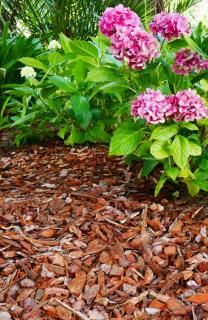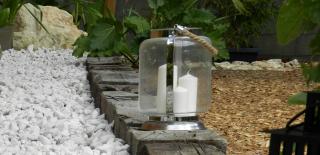

Always 100% natural, plant based mulch, on top of being extremely ornamental, also has the special advantage of turning into excellent fertilizer.
As it breaks down, plant mulch spreads nutrients into the soil, essential elements that will help plants develop well.
Key plant-based mulch facts
Thickness, ornamental – 2 in (5 cm)
Thickness, enrichment – 8 in (20 cm)
Renewal rate – every 6 months to two years
Its also possible to put plant-based mulch as an underlayer to mineral mulch to have the advantages of both.
It is perfectly suited to mulching on flower beds and greenery beds, especially annuals and biennials.
But it is also great for trees and shrubs, rose trees, vegetable patches, heath plants and botanical gardens.

To a certain extent, you can even use kitchen scraps, but it isn’t a very good idea. You’d attract rodents and birds which will dig your flower beds up. Better toss that waste in the compost.
Though it is rich material, compost shouldn’t be used directly as mulch. For mulch to be efficient, it needs a thick layer, about 2 inches / 5 cm. Having that much compost around plants would lead to nitrogen burn and possibly kill weak plants. Nonetheless, a thin layer of compost (half-inch or 2 cm) underneath other plant matter is perfect. This is called topdressing.
Each are ornamental in their own respect, and all share nutrients to the growing bed as well. The origin of the plant mulch, however, influences the richness of the soil once it’s broken down.
Includes grass trimmings, flax mulch, cocoa hull mulch and to a lesser degree recycled waste such as coffee grounds.
Grass-based mulches provide an excellent nitrogen boost for a single season. They break down quickly and their nutrients are ready for use within the season.
However, the nutrient package isn’t as complete as that of wood-based mulches. Grass mulch doesn’t promote soil structure nearly as much as wood-based mulches do.
Includes all sorts of bark mulch, pine bark mulch, wood chips and Bois Raméal Fragmenté or Ramial chipped wood.
Wood, especially hardwood, is made by plants to last for centuries. Loaded with trace elements and minerals, they provide an excellent source of rare nutrients for common flowers, fruits, and vegetables.

Wood requires many more different types of beneficial animals and fungus to break down.
This mulch is 100% organic and can be used in organic farming.
The more you use this option, the more your plants will grow and thrive, all the while adding a beautiful touch to your flower beds and garden!
Read also: